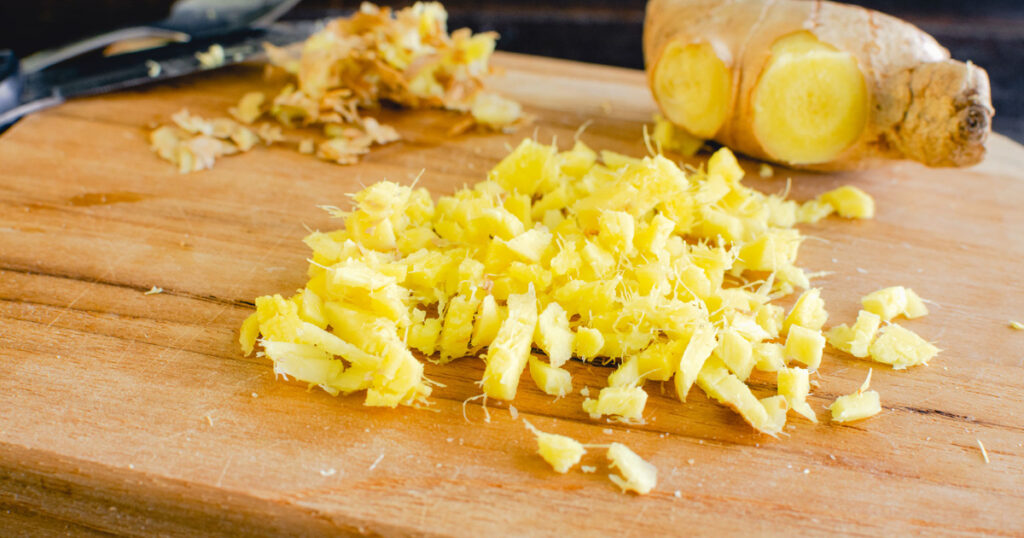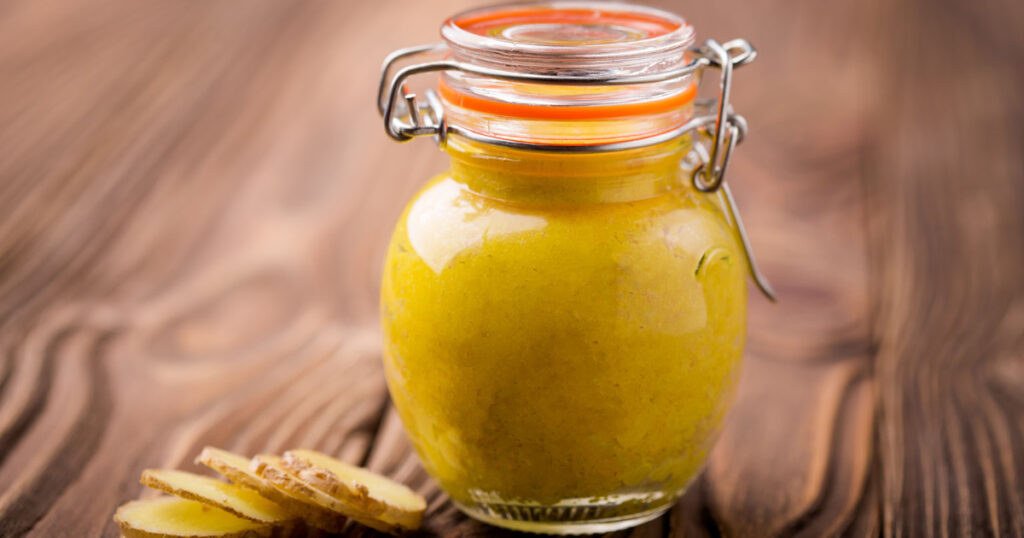Ginger is a versatile ingredient that adds flavor and spice to sweet and savory dishes. When cooking with ginger, you have two main preparation options – minced ginger or ginger paste. Understanding the differences between these two forms allows you to leverage the unique properties of each.
In this post, we’ll explore minced ginger versus ginger paste in depth – from their flavor profiles and uses to how to make each one. Whether you prefer the bright pops of ginger from minced root or the mellow blendability of ginger paste, this guide will help you better understand ginger’s possibilities.
What is Minced Ginger?
Minced ginger refers to fresh ginger root peeled and then finely chopped into tiny pieces. It provides an intense, fresh ginger flavor using raw, unprocessed root. The texture of minced ginger is fibrous, with visible minced bits of ginger.
To get minced ginger, chop it right before using it in recipes. This makes it more tedious to prepare than ginger paste. However, mincing your ginger allows you to control the particle size. Depending on your taste and textural preferences, you can chop it into smaller or larger pieces.
What is Ginger Paste?
Ginger paste starts with a fresh ginger root that gets peeled and chopped. Then it gets puréed and blended into a smooth, spreadable paste. This processing of ginger allows it to be easily scooped and mixed into recipes.
The key advantages of ginger paste are convenience and consistency. Ginger paste delivers even ginger flavor and texture since it is already puréed smooth. It can be prepared ahead in batches and stored for later use. There is no need to chop ginger each time.
Many brands sell prepared ginger paste in tubes or jars. This ready-made paste provides a quick ginger flavor whenever you need it. The intensity of the flavor can vary based on preparation methods by different brands. Ginger paste imparts a more mellow, subtle ginger taste than minced ginger.
How to Make Minced Ginger

Here is a simple process for mincing your fresh ginger at home:
- Peel the fresh ginger root thoroughly with a vegetable peeler or paring knife to remove the thin brown skin.
- Chop the peeled ginger into tiny pieces on a cutting board. Use a sharp chef’s knife and finely mince the ginger.
- For very fine minced ginger, you may need to add a small amount of water to help release the ginger juices and blend the pieces as you mince.
- Chop and mash the ginger into a pile of very small bits. The smaller you mince the pieces, the more smoothly they integrate when cooking.
- Refrigerate minced ginger in an airtight container for up to 1 week. For longer storage, it can be frozen for several months.
How to Make Ginger Paste

To make smooth ginger paste at home:
- Peel and chop the ginger root into small chunks first.
- Add the ginger chunks to a food processor or high-speed blender.
- Process or blend the ginger, adding drops of water as needed to reach a smooth, spreadable consistency.
- For longer lasting paste, you can add a small amount of lemon juice or oil to help preserve it.
- Transfer the ginger paste to a jar or airtight container. Refrigerate for up 3 weeks or freeze for even longer storage.
Flavor Differences
Minced ginger and ginger paste offer varying strengths of ginger flavor:
- Minced ginger has a brighter, more pungent gingery taste. You get more intense spikes of ginger.
- Ginger paste provides a more mellow, subtle ginger flavor. The blending smooths out the sharpness.
- With minced ginger, you get more bursts of ginger flavor and fibrous texture from the bits.
- Ginger paste integrates seamlessly into dishes and sauces with its smooth consistency.
So minced ginger can add more vibrancy, while ginger paste incorporates more evenly into recipes.
Uses in Cooking
Minced ginger and ginger paste can both be used to impart ginger flavor in savory and sweet recipes. But they tend to work better in different applications.
Minced Ginger Uses:
- Adding it to stir-fries and curries to get flecks of ginger in each bite.
- Mixing into marinades, dressings, and sauces to add little bursts of ginger.
- Topping finished dishes like noodles or rice bowls with extra minced ginger.
- Folding into cookie doughs, cakes, and other baked goods to distribute ginger bits throughout.
Ginger Paste Uses:
- Blending into smooth sauces, soups, and gravies for uniform ginger flavor.
- Mixing into dips, hummus, and salad dressings for even distribution.
- Spreading ginger paste evenly onto proteins before cooking to add moistness and tenderize meats.
- Incorporating marinades for meats to help break down fibers.
- Adding to give gingerbread, cookies, and puddings a mild spiciness.
Storage Differences
Minced ginger and ginger paste have different storage life expectancies:
- Minced ginger should be used within 4-5 days when kept refrigerated in an airtight container. The small ginger pieces lose freshness quickly.
- The ginger paste can be refrigerated for up to 3 weeks before it starts losing potency and flavor. The lemon juice or oil help preserve it.
- For longer term storage, minced ginger can be frozen for up to 3 months. Paste can be frozen for up to 4 months.
- When thawed after freezing, minced ginger may turn slightly mushy in texture from the ice crystals rupturing the fiber cells.
- Ginger paste retains its smooth, spreadable texture after being frozen and thawed.
Converting Between Minced and Paste
When swapping minced ginger and ginger paste in recipes, keep in mind:
- 1 tablespoon of minced ginger is equivalent to 1 teaspoon of ginger paste.
- 1 teaspoon of minced ginger equals about 1/2 teaspoon of ginger paste.
- You may need to adjust the amounts depending on the intensity of ginger flavor desired in your dish.
- For bright ginger punctuation, add minced ginger near the end of cooking.
- For mellow background ginger flavor, mix in ginger paste at the beginning of recipes.
Conclusion
Minced ginger and ginger paste each have their time and place in the kitchen. Minced ginger brings vibrant, fresh ginger flavor and texture.
Meanwhile, ginger paste incorporates smoothly for a more subtle ginger taste. Now that you know how to prepare and use both versions, you can choose the right one for your recipes.
So spice up dishes with the power of ginger – either minced for zing or paste for blendability.
FAQ
What are the main differences between minced ginger and ginger paste?
The main differences are texture and flavor. Minced ginger has a fibrous texture with visible ginger pieces that deliver a bright, pungent ginger taste. Ginger paste has a smooth consistency that integrates seamlessly, with a more mellow ginger flavor.
How long does minced ginger last compared to ginger paste?
Minced ginger lasts 4-5 days refrigerated while ginger paste lasts 2-3 weeks refrigerated. For frozen storage, minced ginger keeps for 3 months and ginger paste keeps for 4 months.
Can I substitute ginger paste for minced ginger?
Yes, you can substitute ginger paste for minced ginger. Use about 1 teaspoon ginger paste for every 1 tablespoon minced ginger. You may need to adjust amounts based on the strength of flavor desired.
When would I choose minced ginger versus ginger paste?
Use minced ginger when you want distinct pieces of ginger and pronounced flavor. Use ginger paste when you want a smooth texture without fibrous bits and mellow, blended ginger taste.
How do I make fresh minced ginger and ginger paste at home?
To make minced ginger, peel and finely chop fresh ginger root. To make ginger paste, blend peeled chopped ginger with a little water until smooth. Add lemon juice or oil to help it keep longer.

